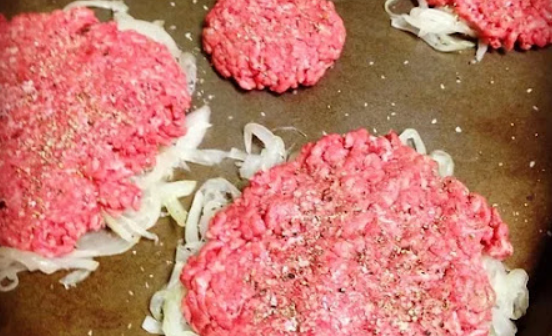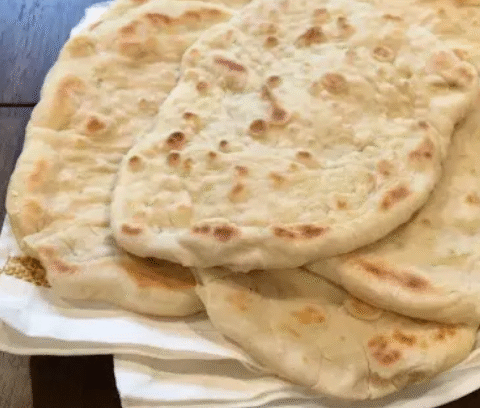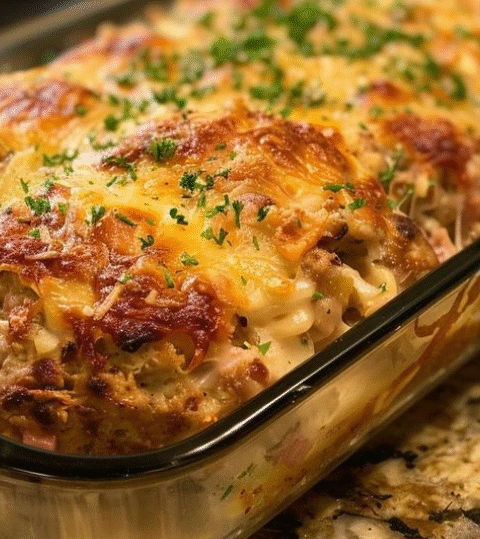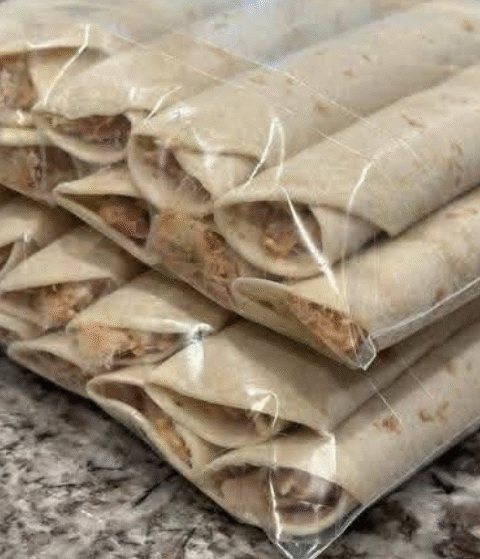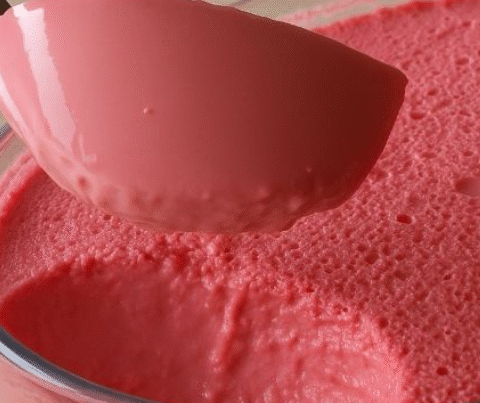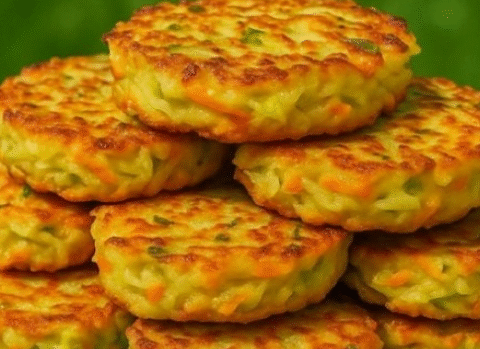Oklahoma Fried Onion Burger — A Juicy, Crispy Taste of the Heartland
If you’ve never tasted a true Oklahoma fried onion burger, you haven’t truly met the soul of American comfort food.
Born in the smoky grills of roadside diners and family‑run cafes across the Great Plains, this humble sandwich is a masterpiece of simplicity: thin, smashed beef patties; a mountain of onions fried right into the meat; and a crispy, caramelized crust that crackles with every bite.
It’s not fancy. It’s not loaded with truffle aioli or brie. It’s beef, onions, salt, and fire — elevated to legendary status.
Once you try one? You’ll understand why it’s a cultural icon, a working‑class staple, and the reason April 21st is celebrated as National Onion Burger Day in El Reno, Oklahoma.
Origins & What Makes It Special
Historical Roots
The fried onion burger, also called the Oklahoma onion burger, originated during the early 20th century, especially the 1920s. :contentReference[oaicite:0]{index=0} It was a creative way to “stretch” more expensive ground beef by mixing in plentiful, cheaper onions. :contentReference[oaicite:1]{index=1} Over time it became a beloved regional classic. :contentReference[oaicite:2]{index=2}
What Defines an Oklahoma Fried Onion Burger
- **Thin, smashed beef patty** cooked over high heat to get a crispy, caramelized crust. :contentReference[oaicite:3]{index=3}
- **Lots of onions**, often thinly sliced, piled on top of the patty (or under before smashing) so that the onions fry, caramelize, and get embedded into the meat. :contentReference[oaicite:4]{index=4}
- **Minimal additions**: often just salt, pepper; cheese is common but optional. Mustard, pickles, bun – simple but effective. :contentReference[oaicite:5]{index=5}
- **Crust and texture**: The smashing technique plus high heat produce browned edges, crispy onions, and a juicy interior. :contentReference[oaicite:6]{index=6}
Ingredients & How to Make It at Home
What You’ll Need
- Ground beef — a fattier blend works better for juicy, crispy edges (e.g. 80/20) :contentReference[oaicite:7]{index=7}
- Onions — thinly sliced (yellow or white) :contentReference[oaicite:8]{index=8}
- Salt & freshly ground black pepper
- Butter or another fat for frying & flavor :contentReference[oaicite:9]{index=9}
- Cheese (optional but common; American cheese works well) :contentReference[oaicite:10]{index=10}
- Burger buns — soft buns; sometimes slightly warmed or steamed rather than heavily toasted :contentReference[oaicite:11]{index=11}
- Optional toppings: pickles, mustard, maybe mayonnaise; kept simple so you don’t overpower the onion flavor. :contentReference[oaicite:12]{index=12}
Step‑by‑Step Cooking Instructions
- Preheat a skillet, griddle, or cast iron pan over high heat. You want it hot so the meat and onions get good sear. :contentReference[oaicite:13]{index=13}
- Divide your ground beef into portions (e.g. balls) instead of forming thick patties first. :contentReference[oaicite:14]{index=14}
- Place each ball on the hot surface, then pile thinly sliced onions on top. Immediately press (“smash”) the beef + onions together using a sturdy spatula so the meat spreads out and the onions embed in. :contentReference[oaicite:15]{index=15}
- Season with salt & pepper. Let cook without disturbing until the edges brown, the meat develops a crust, and onions begin to caramelize. :contentReference[oaicite:16]{index=16}
- Flip carefully so the onion side is now underneath (or still embedded) so both sides get some caramelization. Add cheese if using. :contentReference[oaicite:17]{index=17}
- Warm or lightly steam or toast the buns if desired (some recipes steam the buns with onion vapors) :contentReference[oaicite:18]{index=18}
- Assemble: bun bottom, burger with onions, cheese, any condiments, top bun. Eat while hot. :contentReference[oaicite:19]{index=19}
Nutrition & Health Snapshot
Typical Nutrient Values
| Nutrient | Approximate Value per Burger | Why It Matters |
|---|---|---|
| Calories | ≈ 430‑480 kcal (varies with fat content, cheese, bun, etc.) :contentReference[oaicite:20]{index=20} | Provides plenty of energy; expect this to be a hearty significant meal. |
| Protein | ≈ 25‑35 g depending on beef and amount used :contentReference[oaicite:21]{index=21} | Essential for muscle repair, satiety, and overall nutrition. |
| Fat (Total / Saturated) | High — varies based on meat fat content & cheese; saturated fat can be significant. :contentReference[oaicite:22]{index=22} | Helps flavor and juiciness, but moderate intake is better for heart health. |
| Carbohydrates | ≈ 20‑40 g (mostly from the bun and onions) :contentReference[oaicite:23]{index=23} | Mainly gives energy; type of bread matters—whole grain options change fiber content. |
| Sodium | variable; can be high if using salted cheese, condiments, and salted meat or added salt. :contentReference[oaicite:24]{index=24} | Important to watch for people monitoring sodium or blood pressure. |
| Vitamins & Minerals | Onions bring some vitamin C; beef brings iron, B vitamins; cheese adds calcium. :contentReference[oaicite:25]{index=25} | These contribute to immune function, energy metabolism, bone health, etc. |
Health & Practical Considerations
- Use ground beef with moderate fat (not leanest) to get flavor and good crust, but trim visible fat if needed.
- Cook thoroughly — ground beef should reach safe internal temperature (≈ 160°F / 71°C) to avoid foodborne risk.
- Balance richness with lighter sides — salad, grilled veggies, or citrusy slaw help offset the heaviness.
- Watch condiments and cheese — both add saturated fat, sodium.
- Portion size matters — one burger is filling; maybe lighter meal if paired with heavy sides.
Variations & Tweaks
- Cheese options: American cheese melts very smoothly; cheddar or pepper jack add more flavor. Or skip cheese for a more traditional version. :contentReference[oaicite:26]{index=26}
- Onion type: Sweet onions, yellow onions, white onions all work; cooking time and sweetness vary. Caramelization adds better flavor. :contentReference[oaicite:27]{index=27}
- Meat alternatives or leaner blends: Using beef with less fat (e.g. 85/15 or 90/10) reduces calories/fat but may reduce crispness. Could also experiment with blended meat (beef + pork) or plant‑based substitutes.
- Bun choices: Soft buns (potato buns, brioche) are nice. For lower carb, lettuce wrap or thinner bread. Light toasting or steaming helps. :contentReference[oaicite:28]{index=28}
- Flavor add‑ons: Mustard, pickles, maybe a simple burger sauce; keep them minimal so they don’t overpower the onion + meat combo. :contentReference[oaicite:29]{index=29}
Recipes / Example Versions
Here are a couple of recipe models to illustrate differences:
Example from Delish
Uses 1 lb ground beef (≈ 80/20), 2 large yellow onions, butter, salt & pepper, American cheese, buns, condiments. Prep ~15 min, cook ~40 min. :contentReference[oaicite:30]{index=30}
Example from Serious Eats
One serving ≈ 473 calories; around 20 g fat; 30 g protein. :contentReference[oaicite:31]{index=31}
Frequently Asked Questions (FAQs)
1. Why do you “smash” the burger instead of making thick patties?
Smashing increases the surface area in contact with the hot pan or grill, which encourages browning (Maillard reaction). That crispy crust is a big part of what makes the onion burger special. Thin patties also cook faster and allow onions to mingle with meat.
2. Should the onions be cooked ahead or raw when added?
Typically the onions are raw (thinly sliced) and piled onto the raw beef before smashing. During cooking they caramelize and cook through. Some recipes may sweat or slightly cook onions first to take off harshness or reduce water, but raw gives more direct flavor and crisp edges. :contentReference[oaicite:32]{index=32}
3. What kind of skillet or grill is best?
A heavy skillet or cast iron works great because it retains heat well, delivers even sear. A flat top or griddle is even better if you have large batch. Make sure the surface is really hot before smashing.
4. How do I avoid soggy onions or meat that steams instead of sears?
Use thinly sliced onions, don’t crowd the pan, press onions in firmly when smashing, cook on high heat especially on first side. Also, excess moisture in onions can be dabbed off. At flip, let cooked (bottom) side fully brown before flipping.
5. Can I use leaner meat without losing all the flavor?
Yes — but you may lose some of the crust, juiciness and fat flavor. If using leaner meat, add a little extra fat in the pan (butter or oil) and be careful not to overcook. Also manage expectations for texture.
6. Is cheese traditional or optional?
Cheese is optional. Many traditional versions omit it, sticking to meat‑onion‑bun, sometimes with mustard/pickles. Cheese adds richness and melting texture but changes the balance.
7. What toppings are typical?
Mustard and pickle slices are very common. Some add mayonnaise. Lettuce/tomato are less traditional (because they can mask the onion/meat flavor). Keeping it simple preserves the character. :contentReference[oaicite:33]{index=33}
8. How to adapt for dietary restrictions (e.g. lower fat, gluten‑free)?
Use lean meat, reduce cheese or omit, use lighter condiments. For gluten‑free, use gluten‑free bun or lettuce wrap, ensure seasonings/pan are clean. Onions are naturally gluten‑free.
9. How about scaling up (for many people)?
You can cook multiple patties on a griddle or large flat top. Use separate pans or batches. Keep patties warm in low oven while finishing. Onions can be prepared ahead.
10. What should I serve with the onion burger?
Classic sides: french fries, onion rings, coleslaw, potato salad. Lighter sides: green salad, pickles, roasted vegetables. You can also serve a simple slaw or vinaigrette to cut through richness.
Conclusion
The Oklahoma Fried Onion Burger is proof that sometimes the simplest food is the most memorable. It’s all about texture: crispy edges, caramelized onions, juicy beef. It’s humble, affordable, and full of character. Whether it’s your first time trying one or a nostalgic trip home, this burger deserves a place on your summer cookout menu (or any time you’re craving comfort).
